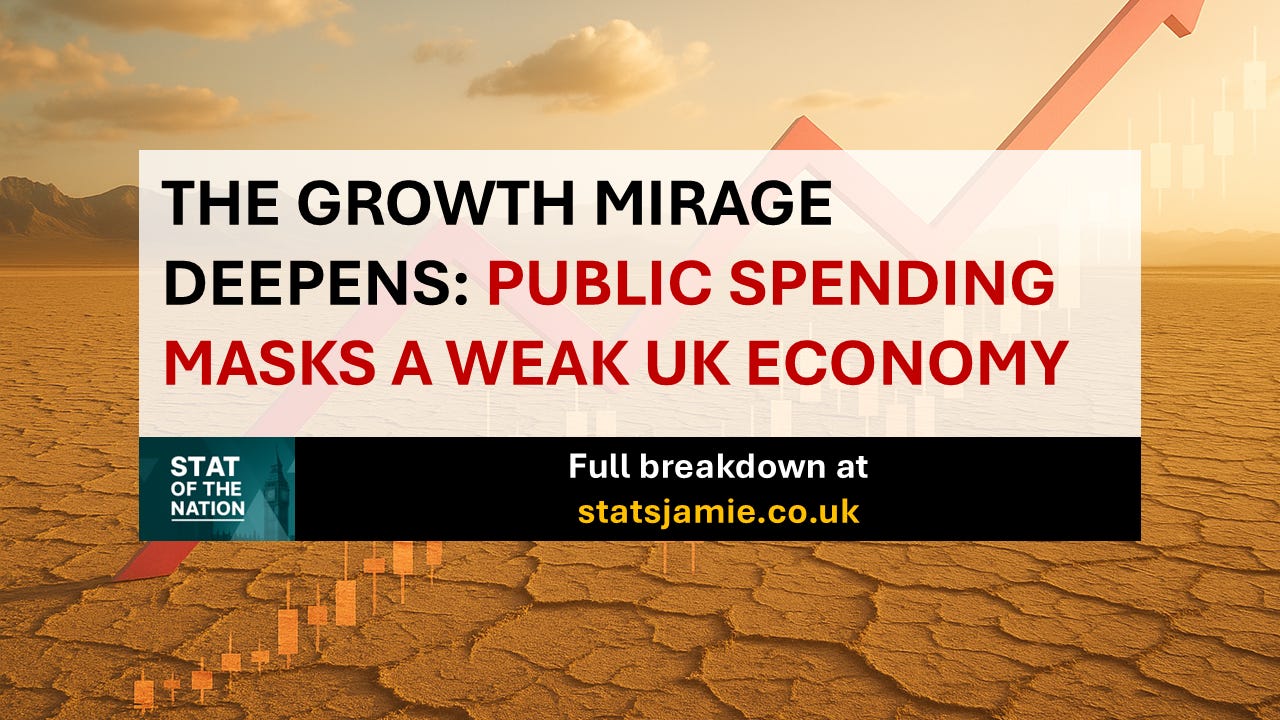🏦 A story of borrowed growth
The latest ONS data show GDP rose just 0.1% in August, after falling by 0.1% in July — leaving overall growth at 0.3% over the past three months.
Even that small uptick is being held up by public spending rather than genuine private-sector strength. Services — which make up four-fifths of the economy — saw no growth at all, while construction fell and production barely improved.
Yesterday I broke down what’s really happening beneath the headlines: excluding
The private economy is shrinking, while the state continues to expand.
123,000 fewer people on payrolls since the election.
200,000 fewer young people in work — a generation Labour forgot.
And public-sector wages are rising faster than private pay — fuelled by borrowing that taxpayers will eventually have to cover.
📊 Read yesterday’s full analysis: The Generation Labour Forgot
💷 Why low growth matters
Low growth doesn’t just mean a weaker economy — it means lower tax receipts and less money for essential services. When growth stalls, governments often respond by raising taxes to plug the gap, which only makes it harder for households and businesses to spend and invest.
It’s a vicious circle: higher taxes squeeze demand, which weakens growth even further.
The better path would be to cut taxes and drive spending, helping businesses expand, hire, and generate the sustainable revenue that public services actually depend on.
📊 The latest numbers
According to the ONS GDP release for August 2025, Britain’s economy is barely moving:
Monthly GDP: +0.1% in August (–0.1% in July)
Three-month growth: +0.3% (June–August)
Services: flat for the second month running
Production: +0.4% in August but –0.3% over three months
Construction: –0.3% in August
Year-on-year: +1.3% — weak once inflation is stripped out
🌍 The global picture — and how the UK compares
The IMF’s latest World Economic Outlook (14 October 2025) adds vital perspective.
It forecasts UK GDP per head rising by only 0.4% in 2025 and 0.5% in 2026 — the lowest in the entire G7.
For context, the IMF projects 1.8% in the United States, 1.6% in Canada, and around 0.8–0.9% in Germany, Italy and Japan.
So even by 2026, Britain is expected to see the slowest improvement in living standards among the world’s major economies.
Headline GDP might edge up, but once you divide it by a growing population, Britain’s economy is effectively standing still per person.
🧾 What’s really driving the numbers
The ONS notes that human health and social-work activities were one of the largest positive contributors to growth in the latest quarter. That tells you all you need to know about where the expansion is coming from — government-funded services, not private-sector dynamism.
It’s another example of what I call Perverse GDP: growth that comes from higher state spending rather than higher productivity.
💬 Closing thought
Until Britain fixes the structural imbalance — where state expansion counts as “growth” while real output stagnates — every 0.1% GDP rise will just be another illusion of prosperity built on debt.
We need a thriving private sector to generate the tax receipts that fund our public services. Without it, the government will keep borrowing to fill the gap, the national debt will worsen, and living standards will continue to erode.
If we don’t change course, an entire generation of young people risks being consigned to the economic scrap heap — locked out of opportunity by high taxes, stagnant growth, and an economy that rewards bureaucracy over productivity.
✍️ Jamie Jenkins
📚 If you found this useful, you might also want to read:
👉 Digital ID for Children — Who’s Really Behind It? — a deep dive into how state control of data and identity intersects with broader debates about power, privacy, and the role of government in everyday life.
Stat of the Nation exists to cut through the spin and show the numbers as they are.
If you value clear, fact-driven analysis — please share this roundup with others. And hit subscribe below to get the stats first, every week.
📲 Follow me here for more daily updates:










